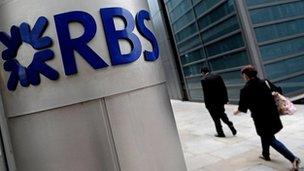A Royal that's not in jubilee mood
- Published

The Royal Bank has set aside hundreds of millions of pounds to compensate customers
A loss of £1.5bn for half a year doesn't look too good, least of all for those of us who are shareholders in Royal Bank of Scotland.
The recovery programme is being "elongated", according to chief executive Stephen Hester. Three years into the five-year programme, he's not saying how long it will take to turn around the stricken financial giant.
To focus on one pre-tax loss figure is to miss a much bigger, more complex and more interesting picture.
Part of that is down to the accounting convention that when assets issued by a bank increase in value, because it's reckoned to be a safer, more attractive bet, then its liabilities increase, in these half-year figures by nearly £3bn. So bizarrely, success breeds bigger losses.
There's success also in its trading. The operating profit was above £1.8bn. The retail bank, serving individual customers, made nearly £1bn in profit last year.
That's the kind of success that will provoke mixed feelings among customers, to put it gently.
Eurozone exposure
If you strip out the non-core bits of the bank that it wants to shed, RBS claims the underlying profit was £3.2bn. That's something of a fantasy figure, while it still struggles with the bad bits of RBS, but it's a measure of where it wants to be.
Part of the unhappier bits of the bank are in exposure to the eurozone, down by 9%, and by 10% in the troubled periphery, to £61bn, much of that in Ireland, and quite a bit in Spain.
And the reasonably valuable bit of the bank that RBS has been forced to sell by the European Commission is causing it even more of a headache than it feared.
The sale to Santander of 178 branches is proving so complex that the completion date is disappearing off towards the end of next year.
Meltdown
The bigger picture also features a list of litigations, investigations and reviews that are continuing to dog the bank.
It's assuming £125m of costs for compensating customers who suffered from the IT meltdown. What it's not (yet) saying is how many customers it lost as a result of that. They've been loyal through the financial meltdown.
It's less clear they'll be loyal through one in which they couldn't access their own money and pay the bills they need to pay.
That's only a provisional figure. It could be much more. And it's before the Financial Services Authority imposes a fine, as it surely will.
Mis-selling
The cost of mis-selling Payment Protection Insurance, in common with other high street banks, continued to burn a large hole in the accounts. The total pay-outs to date have been £1.3bn. That's a big uplift on the previous amount set aside by RBS.
Now there's the mis-selling of interest rate swaps, mainly to businesses, but also to some 'non-sophisticated' retail customers.
It's now taking £50m of provisions for compensation, and that's just a starting figure.
RBS confirms, officially for the first time, that several staff have been fired for their role in fixing the key Libor interest rate. But it's too early to say what the bank's fine for that will be, as it's investigated in several jurisdictions.
Barclays took a £290m hit on Libor rigging. It's not at all clear that RBS will come off more lightly, though it's hard to imagine it can face as much reputational damage as Barclays sustained by being first mover.
Legal bills
And then there are the law suits. In total, RBS is facing unquantified claims over losses to shareholders, starting in the US, and with UK shareholders threatening action.
Much of that is around the rights issue in spring 2008, when the bank raised £12bn, almost all of which vanished by the following October.
On the issuing of mortgage backed securities between 2005 and 2007, RBS is facing law suits totalling $85bn, with claims that RBS issued false or misleading statements about risk and under-writing.
The bankruptcy administrators for fraudster Bernie Madoff are going after RBS for $271m. But these aren't simply trigger-happy American litigators.
The big claims are from the US federal home loan agencies Freddie Mac and Fannie Mae, with the biggest of these suits in Connecticut, for $32bn.
Amid billions of assets listed in the RBS half-year accounts, the lawyers' bills may be relatively small, but the process looks like a huge drag on the bank's recovery.
At least as ominous still is action being taken by US authorities against RBS for the way it's been handling dollar accounts outside the US. The penalties are unclear.
Break-up pressure
You can add to that competition authorities and regulators bearing down on banks' control of the market in personal current accounts and insurance.
And all that underlines how badly wrong things have been going - in case that was in any doubt - but it also underlines how much effort and cost is required if they are to be put right.
Faced again with calls for a break-up of RBS, Stephen Hester has reformulated his argument that big and complicated banks haven't been the problem.
Nor have high-risk investment divisions been the only ones to get it wrong.
Asked if he thinks RBS should be fully nationalised, as floated in the Financial Times this week, he responded that it seems unlikely the taxpayer would want to take on the risk for another £5bn investment.
It's a reminder of what a bizarre position he's in - that he's on the airwaves telling his principle shareholder not to take a bigger risk.
It's hard to see that helping the share price get above the level where it's struggling to get much above 200p - that's after a ten-for-one split of shares, so it equals 20p in old money.
For the British taxpayer to break even, it needs to get above 500p.
- Published28 June 2012
